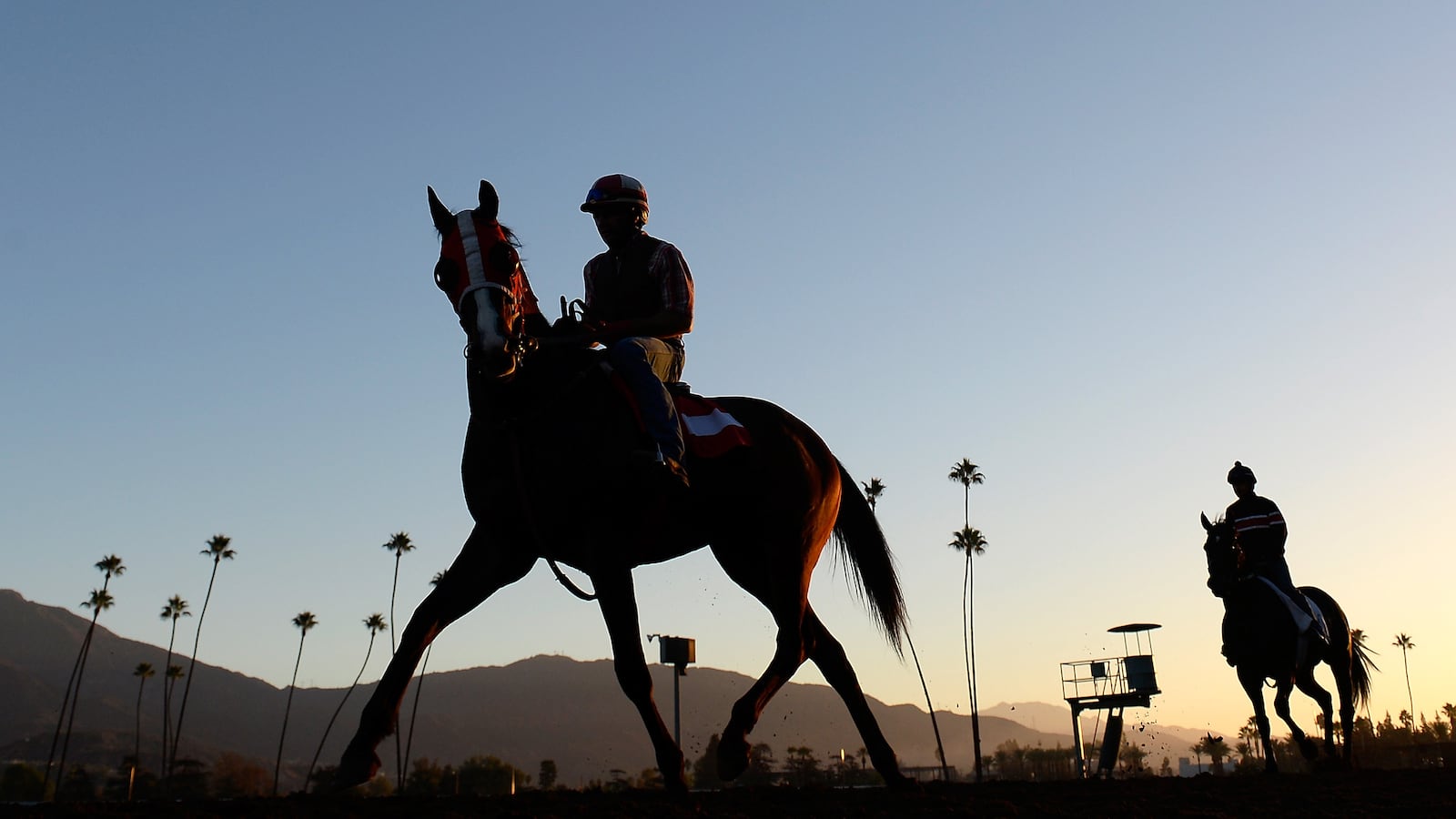Wednesday morning, Santa Anita Park, a colossal art deco racetrack in the Los Angeles suburb of Arcadia, was empty. On the average racing day, the historic landmark, which houses some of the most lucrative events in horse racing, can hold up to 50,000 spectators. But this week, the only real crowds were teams of moving guys, carting off chairs and tables. “It’s a ghost town,” said a secretary, who declined to give her name. The conspicuous emptiness arrived after a string of mysterious horse deaths that have left experts, activists and horse girls confused. When a filly named Lets Light the Way was put down early this week—the 21st fatality since Dec. 26th—Santa Anita’s owners announced Tuesday that the facility would be closed “effective immediately.”
“The safety, health and welfare of the horses and jockeys is our top priority,” said Tim Ritvo, the chief operating officer of the Stronach Group, which owns the Santa Anita track, in a statement. “While we are confident further testing will confirm the soundness of the track, the decision to close is the right thing to do at this time.”

A general view of jockeys and horses racing during the 2014 Sentient Jet Breeders' Cup Juvenile at Santa Anita Park on November 1, 2014 in Arcadia, California.
Harry How/GettyThe problems at Santa Anita first came to light on Feb. 22, when three horses died at the track within the same 16-hour period. At the time, Santa Anita had already racked up 16 deaths, according to a Feb. 10 report—a marked spike from the year prior, when only seven horses had died by that point in the season, making it one of the safest of the past two decades. The three horses—Hot American, Just Forget It, and a thoroughbred named Battle of Midway (something of a celebrity in the equine world for winning the 2017 Breeders’ Cup Dirt Mile)—were euthanized after incurring injuries during races and training at different places on the track.
The rapid-fire fatalities brought the season to a temporary halt. That weekend, the California Horse Racing Board scheduled an emergency meeting with Santa Anita administration, and the management brought on Mick Peterson, an equine safety specialist from the University of Kentucky, to “peel back” the surface of the track and test the soil. But after two days of closure, a committee of Peterson, a former jockey, a trainer, and a member of Santa Anita’s management determined the facility was fine for racing. When the one-mile track reopened, Peterson announced in a Feb. 27 press release that it was “one hundred percent ready.” Three days later, another horse died.
The 20th death was a four-year-old racehorse named Eskenforadrink. The filly had been in the lead of her Saturday race—only her 13th so far, of which she had won two, and finished 2nd twice, according to Los Angeles Times reporter John Cherwa—when she fell and injured her front leg. The day after the horse was put down, animal rights activists showed up outside the track holding signs that read “STOP Killing Horses!” and “Learn the truth: HorseRacingWrongs.com.” PETA Senior Vice President Kathy Guillermo told The Daily Beast that animal rights advocates were calling for a criminal investigation into the trainers and medical examination of all 21 dead horses.
“We know from the necropsies done on horses in California that 90 percent of breaks occur at the site of a pre-existing injury,” Guillermo said. “It’s common knowledge in racing—although they all pretend publicly it’s not—that the legal meds given to horses mask injuries. They give horses anti-inflammatory drugs, painkillers—a common one is phenylbutazone... and if they’re feeling pain, this hides it. They go on the track and the vet doesn’t see that they’re feeling an injury.”

Animal-rights advocates protest the deaths of 20 racehorses in the first two months of this year at the Santa Anita Racetrack in Arcadia, California on March 3, 2019.
Mark Ralston/GettyJust last week, two trainers at Santa Anita, Jorge Periban and Joseph Herrick, were fined $500 each, when tests came back with evidence that their horses, We Will Re Joyce and Lovely Finish had more than the legal dose of the anti-inflammatory drug flunixin and the muscle relaxer 5-hyrdroxydantrolene, respectively. “I suspect it has more to do with the horses than the track,” Guillermo said.
“Something is drastically wrong,” a veteran trainer named Art Sherman told the Los Angeles Times. “I’ve been around a long time and have never seen this... There’s something wrong in the foundation, or something is not right. The only way to find out is shut it down.”
One answer experts are floating is the unusually wet season. The desert conditions of southern California have been upset by a sharp rise in rain levels—nearly 12 inches have fallen since the start of the season—a weather pattern which has already led meteorologists to declare an El Niño year. “I think it’s just all the rain,” said jockey Effrain Hernandez. “We’re not used to having this much rain in this much time.” Another Santa Anita rider, Eswan Flores, chalked up the injuries to bad luck. “The horses are athletes. It’s like any athlete. Horses get sore and horses get hurt.”
In what is now the second closure of the racetrack, the owners have promised a more thorough investigation. In a statement released Wednesday, a spokesperson wrote that additional testing would be conducted by Dennis Moore, a widely respected track expert who will come out of retirement to examine the facility. “Measures will include utilizing an Orono Biomechanical Surface Tester, a device that mimics the impacts of a horse running at full gallop allowing engineers to see how the track holds up,” the statement read. “These test results will be evaluated to ensure track consistency and uniformity for both training and racing.”
The venue will open for simulcasting again on Sunday. All major upcoming races—including the San Felipe and the Santa Anita Handicap, which had been planned for Saturday—will be rescheduled. For now, the racetrack, which calls itself the “Great Race Place,” will stay closed with no end in sight.
“What’s puzzling is why this is happening now,” Guillermo said. “The number of horses who have broken bones and died on California tracks has been decreasing for the last decade. It’s very puzzling that this is happening. I suspect it has to do with the condition of the horses. Why is it now?”







